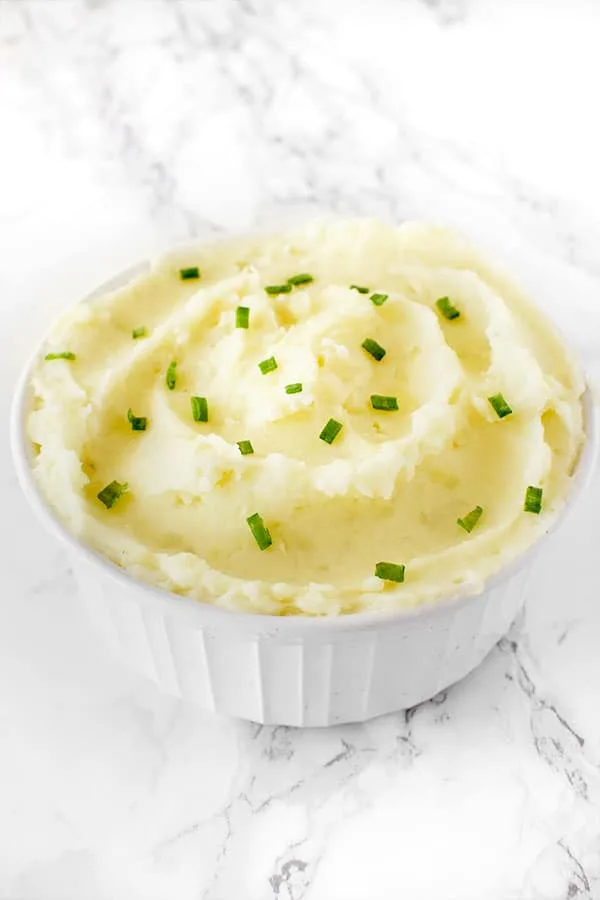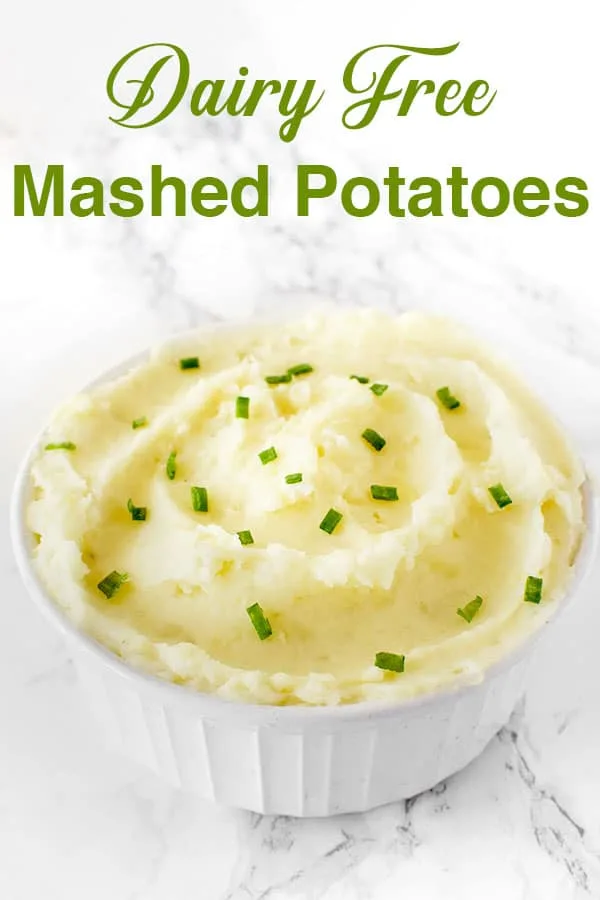These dairy free mashed potatoes are made without milk and without butter. However, they are still creamy and can be made ahead of time thanks to a secrete ingredient.

Mashed potatoes are a classic American side dish that is served along side anything from steak or fried chicken.
This is because potatoes originated in the Americas as opposed to rice has a long history in Asia, the Middle East, and even Africa.
Mashed potatoes usually contain dairy. In fact, the very first recipe calls for two pounds of potatoes, a pint of milk, and quarter of a pound of butter!
Today you can find mashed potato recipes that even call for creamed cheese, sour cream, and cheese.
This mashed potato recipe is made without milk or butter and or any other dairy for that matter.
History of Mashed Potatoes
While rice was imported into Europe since ancient times, brought from Asia by returning soldiers from Alexander the Great's military and later imported from Egypt.
Potatoes however, while commonly associated with Ireland, were brought to Europe by the Spanish the second half of the 1500's.
Potatoes became an international staple because they were cheap to grow and high in nutrition.
They are a rich source of vitamin B6 and vitamin C providing almost 25% of your daily value of each.
Potatoes are very versatile and mashed potatoes are arguably the most common way they are prepared and eaten.
The first recipe for mashed potatoes first appeared in The Art of Cookery by Hannah Glasse in 1747.
Boil your Potatoes, peel them, and put them into a Sauce-pan, math them well: To two Pounds of Potatoes put a Pint of Milk, a little Salt, stir them well together, take care they don’t stick to the Bottom, then take a quarter of a Pound of Butter, stir in and serve it up.
While the Art of Cookery originated in England, it was very popular in the Thirteen Colonies as well in America after the War of Independence.
In fact, Benjamin Franklin, Thomas Jefferson and George Washington all with owned copies of it.
The secret to creamy and smooth mashed potatoes without milk
You actually don't need milk to make your mashed potatoes smooth, you need any liquid. I like using the starchy potato water because I find it makes it extra smooth.
Now the secrete to really creamy mashed potatoes is actually mayonnaise. I know it sounds weird but it is so simple and nothing works better!
About Dairy Free Mashed Potatoes
While mashed potato don't have to contain dairy, they almost always do.
Most mashed potato recipes include milk, buttermilk, cream, butter, sour cream, and/or cheese.
You can make mashed potatoes without milk by replacing it with another liquid such as almond milk, oat milk, coconut milk, reserved starchy water, regular water, chicken stock, or vegetable stock.
It doesn't really make a difference if you use milk, water, or any other liquid because one isn't necessarily better than the other.
To replace buttermilk in mashed potatoes, substitute it with dairy free buttermilk by using buttermilk made with oat milk or buttermilk made with almond milk.
To make mashed potatoes without butter you need to substitute the fat in butter with another form of fat like oil.
Mayonnaise is also a surprisingly good substitute for butter and sour cream in mashed potatoes.
How to make creamy mashed potatoes without milk?
Additions like dairy free milk, coconut cream, almond cooking milk, water, and mayonnaise can all help make something creamy without dairy.
What you use really depends on what you are making. With dairy free mashed potatoes, any of these options work.
Milk actually doesn't make mashed potatoes super creamy. It mostly just adds liquid so the potatoes aren't dry.
It is the addition of fat that makes mashed potatoes and other dishes creamy.
This fat usually appears in the form of butter or sometimes creamy cheese or even sour cream.
However, you can use other forms of fat such as oil to get that creaminess.
To make them extra creamy, add a little bit of mayonnaise like I do in this recipe. You won't taste the mayonnaise but the mashed potatoes will be oh so creamy!
How can I thicken potatoes without milk?
My favorite way to thicken mashed potatoes without milk is just a little bit of mayonnaise like I do in this recipe.
How do you make mashed potatoes without milk or butter?
You can easily make mashed potatoes without milk and butter.
What you need is a liquid - which ever you prefer - so the potatoes aren't dry.
Then, you need a fat to help make them creamy. Butter is usually used but fats like olive oil, animal fats, and even mayonnaise can be used.
My mashed potatoes without butter call for olive oil for example but my go to is usually mayonnaise like I use in this recipe.
Can I use almond milk in mashed potatoes?
Yes, you can make mashed potatoes with almond milk. Unsweetened barista styled almond milk is best because it is most similar to milk.
Can you make mashed potatoes with oat milk?
Yes, you can make mashed potatoes with oat milk. For best results, I recommend using a neutral flavored full fat oat milk though.
Which dairy free milk should I use?
Honestly, it's whatever you have on hand or prefer.
My go-to is a neutral flavored full fat oat milk because I find that they are the most similar to regular full fat milk.
Almond milk works well here, too. I personally like using an unsweetened barista almond milk because it is more similar to regular full fat milk, but whatever you have will work.
You can also use coconut milk, though it may have a subtle coconut flavor if you do. Coconut milk has more fat and is similar to using a light cream, but it won't make a noticeable difference.
I've never used soy milk, so I don't have any opinions on it, but you can use that as well.
Can you substitute mayonnaise for milk in mashed potatoes?
Mayonnaise is my secret ingredient for having incredibly creamy mashed potatoes.
However, you do still need to make sure your mashed potatoes have enough liquid in them so that they are not dry.
Once you do however, mayonnaise absolutely can be used instead of milk to add creaminess.
What I do is, I first make sure that the potatoes aren't dry after mashing them. If they are, I add a little liquid at a time until they look moist even if not creamy.
At this point I add a little mayonnaise and mix it in. If this is not enough I continue the process until I reach my desired consistency.
The reason I don't add it all at once is because I think mashed potatoes with too much mayonnaise tastes like potato salad.
Do You Peal Potatoes Before Boiling for Mashed Potatoes?
You can but you don't have to. Potatoes that have clean skin can be washed and left on.
I like leaving the skins on but I choose which way to do it based on the preferences of whoever else will be eating it.
Types of Potatoes
There are generally three types of potatoes: waxy, starchy, and those in between.
Waxy
Waxy potatoes, such as Red Bliss and fingerlings, have a smooth skin and creamy, almost shiny flesh.
Because waxy potatoes are relatively low in starch and high in moisture, they stay intact when they’re cooked.
These potatoes have a nice potato flavor and hold up when boiled or baked even if sliced or cubed.
Starchy aka Floury
The most common example of starchy potato are russets aka Idaho potatoes.
As you may have guessed by their name, they're higher in starch and lower in moisture than waxy potatoes. They have matte-skinned and fall apart when boiled.
Starchy potatoes are ideal for adding creaminess to puréed soups or providing the airy, whipped texture to a mash. They are also good for roasting and frying.
In-between
These fall somewhere between the waxy and floury making them the “all-purpose” potatoes. The most commonly known of them are Yukon Golds.
Because they hold their shape when boiled, grated, or fried and yield to mashing, they’re very versatile.
Best For Mashed Potatoes
Since the waxy are most flavorful but the starchy are airiest, for the ideal mashed potatoes use half and half. This is a tip I picked up from the New York Times.
However, if you could only choose one, choose the in between option like Yukon Gold.
Or if where you live you don’t have any clear way to know what type of potato you have available, use whatever you have.
Water Temperature
Believe it or not, it's best to begin cooking potatoes in cold water. It doesn't have to be chilled, just the cold side from the tap.
While this may sound counter intuitive, cold water helps the potatoes cook more evenly.
Also, if it's better that way, why waste the gas and cooking time by boiling the water?
Secret Ingredient
My secret ingredient to perfectly creamy mashed potatoes is… mayonnaise!
Shocking right?
Mayonnaise is actually great in cakes, quick breads, and when used for grilling, frying, and roasting.
I use a little bit of it in here because I like letting the potatoes speak for themselves. However, you can use up to half a cup if you want a more pronounced flavor.
So why mayonnaise? Because it makes your mashed potatoes creamy, and as a bonus, it doesn’t harden up in the refrigerator, so you can make them ahead of time.
Even if you don't like mayonnaise don't worry, you don't taste it at all when it's just two tablespoons for 2 pounds of potatoes.
Make Ahead of time
Unlike typical mashed potatoes, these mashed potatoes can be made ahead of time. Usually mashed potatoes get hard in the fridge due to all the butter but the mayonnaise keeps these just as creamy.
Simply make the day before (or even a few days before) and reheat when ready to serve.
How To Store
Place in an airtight container or leave in a bowl and wrap in plastic wrap and refrigerate.
Mashed Potatoes without Milk

These dairy free mashed potatoes made without milk or cream. Still, these mashed potatoes are light in calories and extremely creamy.
Ingredients
- 2 pound potatoes, peeled and cubed (900 grams)
- ¼ cup chicken or vegetable stock (60 milliliters)
- 5-6 roasted garlic cloves, optional
- 2 tablespoon mayonnaise
Instructions
- Cover potatoes with water in 2-quart saucepan. Bring to a boil over high heat.
- Reduce heat to low and simmer 10 minutes or until potatoes are tender. Drain. If desired, reserve 3 tablespoons of water to use instead of stock.
- Mash the potatoes with the stock or reserved water and garlic if desired.
- Add the mayonnaise. Mash until creamy.
Notes
If desired, you can use a dairy free milk instead of the reserved water.
I like my mashed potatoes to taste mostly like potatoes to let the main dish really shine, however, you can add up to ½ cup (8 tablespoons) of mayonnaise if desired.
Nutrition Information:
Yield:
6Serving Size:
1Amount Per Serving: Calories: 172Total Fat: 4gSaturated Fat: 1gTrans Fat: 0gUnsaturated Fat: 3gCholesterol: 2mgSodium: 44mgCarbohydrates: 32gFiber: 3gSugar: 2gProtein: 4g

KTinSA
Tuesday 26th of January 2021
I loved using the mayonnaise! Tried it last night and I am a convert. I will tell you that instead of water, I always use vegetable broth to boil my potatoes. It takes a little (2 minutes maybe) longer to boil, but the flavor is out of this world!
ElissaBeth
Wednesday 27th of January 2021
It is amazing how big a difference the mayonnaise makes isn't it!